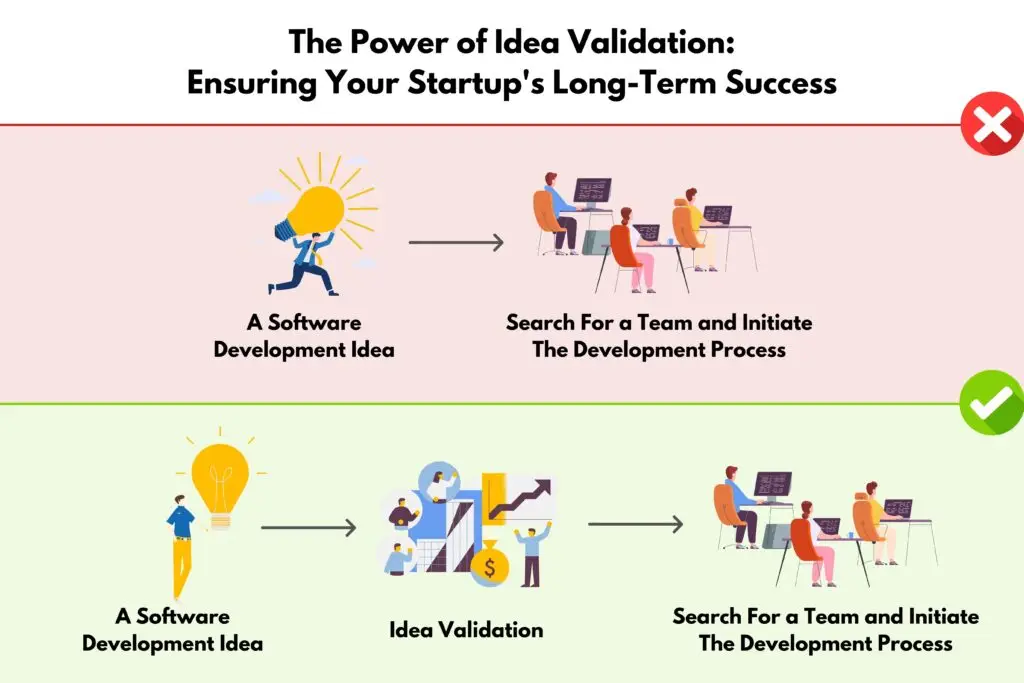
Estimated reading time: 12 minutes
Key Takeaways
- Validating your startup idea significantly increases your chances of success.
- Engage in thorough market research to understand your target market and competition.
- Use customer discovery processes to gather direct feedback from potential customers.
- Apply lean startup techniques to test assumptions quickly and efficiently.
- Avoid common pitfalls like confirmation bias and over-reliance on personal networks.
Table of Contents
- Understanding the Importance of Startup Idea Validation
- Step 1: Conducting Market Research for Startups
- Step 2: Engaging in the Customer Discovery Process
- Step 3: Applying Lean Startup Validation Techniques
- Step 4: Early Market Testing Strategies
- Common Validation Pitfalls to Avoid
- Taking Action: Your Validation Roadmap
- Additional Resources
- Conclusion
Understanding the Importance of Startup Idea Validation
Startup idea validation is the process of gathering evidence and customer feedback to determine whether a product or service will fulfill a genuine need in the marketplace. While validation doesn’t guarantee success, it significantly increases your chances of building something people actually want.
According to Entrepreneur magazine, businesses that properly validate their ideas are 2-3 times more likely to succeed than those that don’t. This process helps you:
- Minimize risk
- Save time and resources
- Better understand your target market
- Identify potential challenges early
Step 1: Conducting Market Research for Startups
Effective market research forms the foundation of successful idea validation. Here’s how to conduct thorough market research:
Identifying Your Target Market
Start by defining your ideal customer using these characteristics:
- Demographic (age, gender, income)
- Geographic (location, market size)
- Psychographic (interests, values)
- Behavioral (buying habits, preferences)
Use tools like Statista and Pew Research to gather reliable demographic data.
Analyzing Competitors
Conduct a thorough competitor analysis by:
- Identifying direct and indirect competitors
- Analyzing their strengths and weaknesses
- Understanding their market positioning
- Evaluating their pricing strategies
Tools like SEMrush can help track competitor performance and strategies.
Understanding Industry Trends
Use these resources to stay informed:
- Google Trends for search interest patterns
- Industry reports from Forrester Research
- Social media listening tools like Hootsuite
- Trade publications and news sources
Assessing Market Size
Calculate these key metrics:
- Total Addressable Market (TAM)
- Serviceable Available Market (SAM)
- Serviceable Obtainable Market (SOM)
Step 2: Engaging in the Customer Discovery Process
Customer discovery involves direct interaction with potential customers to understand their needs and pain points.
Creating Interview Strategy
Develop your approach:
- Create detailed buyer personas
- Prepare open-ended questions
- Plan for objective data collection
- Set clear goals for each interview
Conducting Customer Interviews
Follow these best practices:
- Ask about problems, not solutions
- Listen more than you speak
- Document responses carefully
- Look for patterns in feedback
Key questions to ask:
- “What challenges do you face with [specific problem]?”
- “How do you currently solve this issue?”
- “What would make your life easier regarding this problem?”
Use HubSpot’s buyer persona templates to organize your findings.
Step 3: Applying Lean Startup Validation Techniques
The Lean Startup methodology focuses on quick, iterative testing to validate assumptions.
Building a Minimum Viable Product (MVP)
Choose the right MVP type:
- Landing Pages (using tools like Unbounce)
- Explainer Videos
- Prototype Demonstrations
- Wizard of Oz MVPs (manual backend processes)
Implementing the Build-Measure-Learn Loop
Follow this cycle:
- Build: Create minimal product version
- Measure: Collect user data
- Learn: Analyze results
- Iterate: Make improvements based on findings
Example: Dropbox validated their idea with just an explainer video, generating 75,000 signups overnight.
Step 4: Early Market Testing Strategies
Implement these testing methods to validate market fit:
A/B Testing
Test different versions of:
- Landing pages
- Marketing messages
- Pricing strategies
- Feature sets
Use tools like Optimizely or VWO for testing.
Crowdfunding Campaigns
Launch campaigns on platforms like Kickstarter or Indiegogo to:
- Validate demand
- Build early adopter community
- Raise initial capital
Pre-launch Landing Pages
Create effective landing pages:
- Clear value proposition
- Email signup forms
- Social proof elements
- Compelling calls-to-action
Common Validation Pitfalls to Avoid
Watch out for these common mistakes:
Confirmation Bias
- Solution: Actively seek contrary evidence
- Document all feedback, positive and negative
- Use objective metrics for decision-making
Source: The Founder’s Mental Toolkit
Over-reliance on Personal Network
- Expand beyond friends and family
- Seek honest, unbiased feedback
- Connect with real potential customers
Source: What No One Tells You About Being a Startup Founder
Analysis Paralysis
- Set clear validation milestones
- Define success metrics upfront
- Move forward when sufficient data is gathered
Taking Action: Your Validation Roadmap
Follow this step-by-step approach:
- Start with extensive market research
- Conduct at least 20 customer interviews
- Build and test an MVP
- Gather and analyze market feedback
- Make data-driven decisions about proceeding
Remember: Validation is an ongoing process, not a one-time event.
Additional Resources
Deepen your knowledge with these resources:
Books:
- “The Lean Startup” by Eric Ries
- “The Mom Test” by Rob Fitzpatrick
Tools:
- Typeform for surveys
- Hotjar for user behavior analysis
- Launchrock for landing pages
Conclusion
Validating your startup idea is crucial for success. By following this comprehensive approach to validation—combining market research, customer discovery, lean startup techniques, and early market testing—you’ll be well-equipped to evaluate and refine your startup idea.
Remember, the goal isn’t to prove your idea is perfect, but to learn whether it solves a real problem for real customers in a viable way.
What methods have you used to validate your startup ideas? Share your experiences in the comments below!
